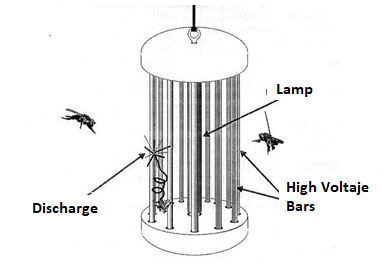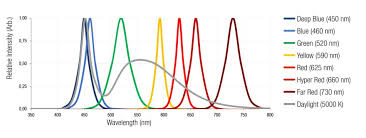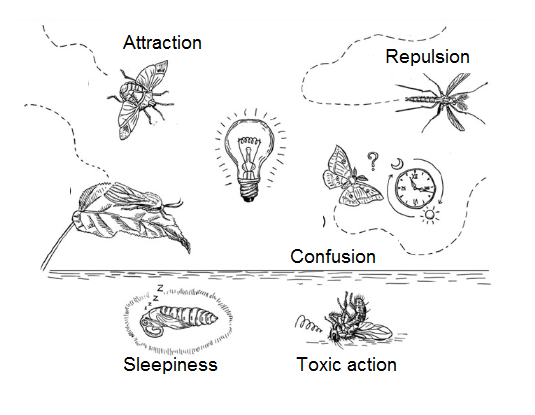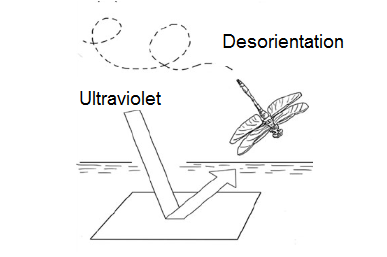Light has special effects on both plants and insects and this taking into account both insects that bring benefits and those that are undesirable (pests). During our career we have already published a large number of projects that involve the interaction of equipment that uses light with insects.
We can mention the Ecological Trap, Insect Killer, Repellents and many others available on this site. In Figure 1, we have an ecological trap that uses a fluorescent lamp to attract insects, published in our article Insect killer (BM081).

This trap produces a high voltage discharge in the insect that tries to reach the lamp when it passes between the electrified bars.
At the time, we used a black fluorescent (UV) light, in which case the attraction was not “selective”, as the lamp had a wide spectrum. With the use of LEDs of specific wavelengths, this design can be improved.
The fact is that we know that the light of certain colors (wavelengths) has special effects on certain types of insects, which allows us to think and devices capable of selective action, scaring away pests, attracting beneficial insects or even stimulating plants.
There is already a wide application of LEDs in horticulture, with the production of light in the lengths in which the plant growth is greater and thus enabling the development of high-performance greenhouses.
However, we can go further and create new applications by taking advantage of the emission of specific wavelength LEDs and using them in pest control. Browsing the internet, we found several works on the subject, from which we took advantage of a lot of information. We can mention two in particular that may be useful for readers who read in English and that we put as a reference at the end of this article.
The light and the insects
The first point to be considered, when using light in pest control, comes from the fact that insects have a different visual spectrum than ours. Insects can see ultraviolet light and in many species, as in the case of bees, the perception of red light and below (infrared) does not exist.

This spectrum is due to the nature of sunlight, which covers these bands and, therefore, nature took advantage of the sensory development of the different species according to their survival needs.
It should also be considered that many insects have nocturnal habits and, for this reason, they have developed sensory organs with sensitivity appropriate to their survival needs.
The important fact that must be taken into account, however, is that LEDs have spectra and if we study the specific wavelengths that have an effect on them, we can create devices of great use for agriculture.
In Figure 3, we show the emission curves of common LEDs, showing that they occupy a very narrow spectrum.

An interesting illustration, that we take advantage of one of those documentation on the internet adapting it to our purposes, is the one that shows how the different species of insects react to light sources, both natural and artificial. We see, for example, that while some moths are attracted to artificial sources of light, mosquitoes are repelled. (We remembered a song by Adoniran Barbosa, Brazilian musician, that talks about the attraction of the moths for the “limpids”).

Note that in the case of moths, the attraction or repulsion may be associated with the circadian rhythm, depending on the time of the day when they occur.
Another interesting fact that we found in the documentation, which can be accessed in our references at the end of this article, is that the ambient light can help in the orientation of insects and not only in visibility. Thus, dragonflies have dorsal ultraviolet light sensors. A reflection of this radiation on an object on the ground can cause its disorientation, as shown in Figure 5.

Based on these facts, we can design light-emitting devices at certain wavelengths with applications in both insect attraction and repulsion.
Available LEDs
The availability of high efficiency LEDs can help a lot in the development of devices that until then were not feasible for both consumption and performance. Fluorescent and incandescent lamps, in addition to a wide spectrum that does not facilitate their use, except with the help of filters (which are expensive), had to be powered by high power sources.
Several companies such as Wurth, OSRAM, Lumileds, ROHM, etc., that have their products distributed by Mouser Electronics, providing specific LEDs for agricultural applications.
Many have optimized emission curves to improve plant growth in greenhouses and other environments. LEDs with emission curves which do not harm the environment are also found, such as those used in public lighting, gardens and other places at night, so as to prevent problems of growth or reproduction of plants from manifesting, due to the alteration of the circadian rhythm, repulsion of nocturnal insects vital to pollination and others.
Naturally, a much deeper study of the applications can be developed, and even the impacts of existing applications, need to be done. We can quote some of them as:
- Effects of different wavelengths on pollinating insects, with a basic approach in agriculture and an additional approach in parks and gardens, taking into account the public lighting.
- Alteration of the circadian rhythm, both in the case of plants and insects that can be useful to agriculture.
- Repulsion and attraction of insects that can help in the control of pests, for example, being predators of harmful insects.
Finally, there is a wide field of research and project development which can be carried out to help us have a pest-free agriculture, such as higher yield, using non-aggressive means to the environment, such as the use of light.
The availability of LEDs which can emit narrow spectra in almost any part of it, from infrared to ultraviolet, opens up an immense field of possibilities for those who venture into a more intense research. New products can help us keep our planet clean, eliminating pesticides and everything else that can affect our quality of life and the balance of our planet.
References
- Journal of Chemical and Pharmaceutical Research - Research on the design and installation techniques of solar LED pest control light Li Tianhua, Pan Zhengkun and Yang Sha -2014 - http://www.jocpr.com/articles/research-on-the-design-and-installation-techniques-of-solar-led-pest-control-light.pdf
- Prospecting the use of artificial lighting for integrated pest management - Acta Horticulturae - https://www.researchgate.net/publication/263652475_Prospecting_the_use_of_artifical_lighting_for_integrated_pest_management
- Insect reactions to light and its applications to pest management - Applied Entomology and Zoology - https://www.researchgate.net/publication/258168804_Insect_reactions_to_light_and_its_applications_to_pest_management



